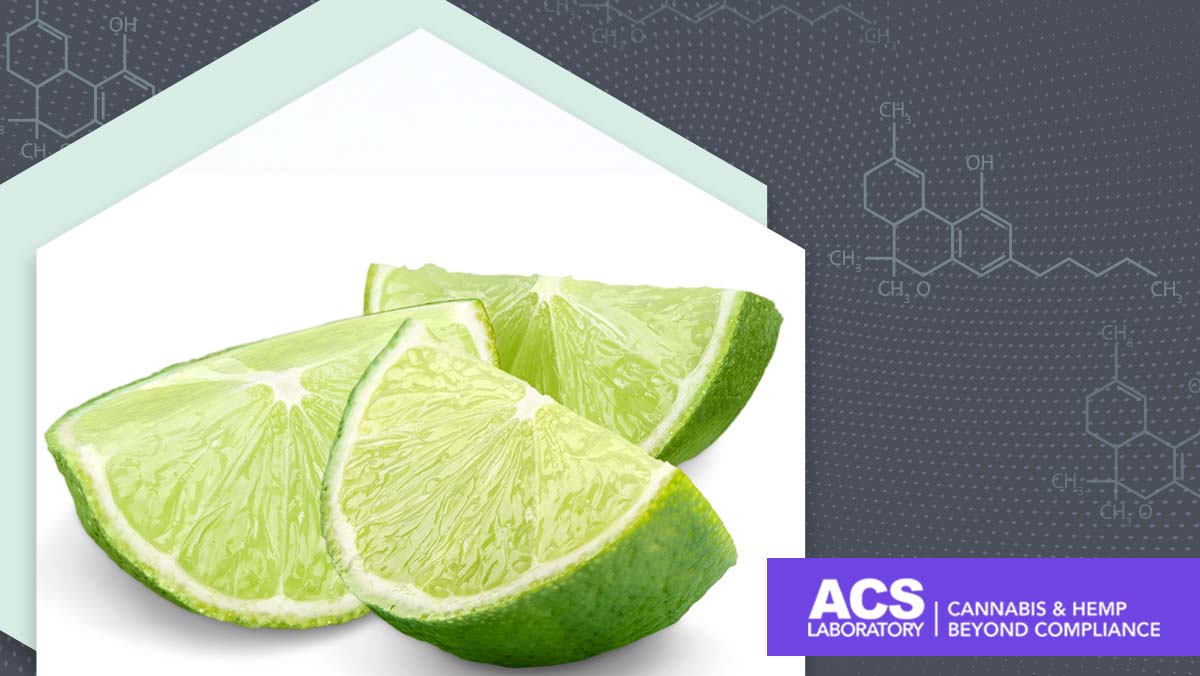Terpene Tuesdays: Everything You Need to Know About Sabinene Hydrate Flavor, Fragrance, and Benefits
Have you enjoyed a meal seasoned with black pepper, a carrot cake spiced with nutmeg, or the aromatic pine scent of a spruce tree during the holidays?
In that case, you are already familiar with sabinene hydrate or simply sabinene. This terpene is present in holm oak and spruce trees, juniper bushes, clove plants, spearmint and peppermint oils, spicy herbs and citrus fruits, and cannabis.
Sabinene is a vital component of various plant essential oils, including cannabis. Its spicy scent and flavor profile makes it a popular ingredient in the perfume and flavor industries. It also displays possible antioxidant, anti-inflammatory, and antimicrobial uses, giving it pharmaceutical potential to soothe problematic skin conditions, relieve arthritis pain, and aid digestion.
What Do Terpenes Like Sabinene Hydrate Do for Plants and Humans?
Terpenes like sabinene hydrate appear in all plants. As the main compounds in the plant’s essential oils, they are responsible for every plant’s unique scent, taste, and color. They also help plants attract pollinators like bees while protecting against outside factors like UV rays, fungi, bacteria, and insects.
In cannabis, terpenes contribute to each strain’s sensory experience and therapeutic benefits.
Cannabis contains over 200 different terpenes that appear in different concentration levels. The cannabis experience differs from strain to strain due to these varying terpene levels across cultivars. For instance, strains featuring higher sabinene levels will have pine, mint, and spicy flavor profiles. Cannabis strains with high sabinene content tend to be relaxing, helping ease symptoms of depression, stress, pain, and insomnia.
What Is Sabinene Hydrate?
Scientifically, sabinene is a monoterpene, similar to other terpenes in many plants like cannabis, such as carene and pinene. Sabinene contributes to the spiciness of black pepper and is a major constituent of essential oils with therapeutic qualities, such as carrot seed oil and tea tree oil.
Although it occurs in lower quantities than other compounds, sabinene contributes a spicy, citrusy, and piney flavor and aroma profile to many cannabis strains. Sabinene could be part of the mix if a cultivar exudes a minty, peppery fragrance and has soothing effects that melt away anxiety. Sabinene’s pine and woody undertones can help evoke being surrounded by fragrant trees in the woods.
Its distinctive warm and peppery scent makes sabinene hydrate popular in aromatherapy. It lends a minty, refreshing scent in fragrance manufacturing and adds zest to beverages, desserts, and candies as a food flavoring. Research suggests sabinene may be a potential weapon against oxidation that causes the skin to age faster. It also possesses antibacterial characteristics that ward off illness.
Antioxidant Properties of Sabinene Hydrate
Oxidative stress is responsible for many health ailments, such as accelerated aging, high blood pressure, and increased risk of cancer, heart disease, and other chronic conditions. Antioxidants are essential for stopping oxidative stress by neutralizing free radicals, a molecule that can damage cells. Research shows sabinene has the potential as a natural antioxidant to help maintain cell health, which can prevent early aging, cancer, and other health issues.
- A 2015 study investigating the properties of several terpenes found that sabinene provided significant protection from oxidative deterioration.
- Sabinene is a major component of carrot seed oil, which showed effective antioxidant properties in animal studies and potential benefits to ward off liver damage.
- A study analyzing carrot seed essential oil featuring sabinene suggests it has benefits in cosmetics for skin rejuvenation.
- A study suggested that sabinene hydrate may reduce the harmful side effects of certain chemotherapy treatments without lowering their anti-cancer effects.
Antibacterial and Antimicrobial Properties of Sabinene Hydrate
Sabinene demonstrates antimicrobial and antibacterial qualities that can protect against fungal infections and illnesses resistant to antibiotics. For example, the leaves of Lippia javanica featuring sabinene as a main component can treat several skin diseases in Ethiopia.
- A 2015 study showed the presence of sabinene in wild juniper berry oil could protect against Streptococcus pneumoniae, the bacteria responsible for pneumonia, and Staphylococcus aureus, which causes dangerous conditions such as meningitis and toxic shock syndrome.
- An antifungal study found that sabinene in the essential oil of water hemlock could protect against skin rashes and meningitis. It was particularly effective against dermatophytes and Cryptococcus neoformans, two types of fungus.
- A study investigating the antimicrobial properties of the essential oils from the Cupressaceae plant showed sabinene fought against Streptococcus, Influenzae, Campylobacter, and E. coli bacteria.
- A study on sweet marjoram revealed sabinene hydrate as the more important compound responsible for inhibiting bacterial growth. Another study into the effects of sweet marjoram showed sabinene stops bacteria from forming protective biofilms, allowing it to inhibit several drug-resistant E. coli strains.
Anti-Inflammatory Properties of Sabinene Hydrate
Consuming or applying sabinene hydrate reduces inflammation, which can help those dealing with the pain, heat, or reduced movement that occurs when inflammation gets out of control.
- A 2013 study investigating the effects of the essential oils in the water-hemlock plant found that sabinene demonstrated strong anti-inflammatory activity.
- Findings on sabinene as an active ingredient in chrysanthemum flower essential oil showed it had a skin-regenerating effect and could help prevent skeletal muscle atrophy.
- Tea tree oil featuring sabinene has anti-inflammatory properties that can treat skin irritations. Carrot seed essential oil with sabinene also has reported anti-inflammatory properties that can soothe the skin and scalp.
Sabinene Hydrate to Improve Oral Health
Sabinene’s antibacterial properties can protect against tooth decay and might prove useful as an ingredient in future oral healthcare products.
- A 2019 study found that sabinene reduced the growth of bacteria associated with dental cavities, reducing acid production and biofilm formation.
What Foods Are High in Sabinene Hydrate?
Sabinene hydrate is one of the main compounds in spicy black pepper, earthy and soothing carrot seed oil, and the seeds of Myristica fragrans, the world’s main source of nutmeg. Sabinene occurs in many spices, herbs, and citrus fruits, including:
- Basil
- Thyme
- Rosemary
- Marjoram
- Cloves
- Cardamom
- Oregano
- Mint
- Lemon
- Lime
- Grapefruit
- Blood and mandarin oranges
What Is the Best Form of Sabinene Hydrate?
Sabinene hydrate is most prominent in the essential oils of specific trees and plants, especially carrot seed oil, which has antibacterial, antifungal, anti-inflammatory, and antioxidant properties.
Consuming cannabis products is another great way to tap into the therapeutic qualities of terpenes like sabinene. Because high-heat applications may burn off terpenes before they can have effects, lower-temperature heating or vaporization seems better suited to maximize terpene experiences with cannabis.
How to Consume Cannabis to Get the Most Sabinene Hydrate Absorbed into Your Body
Sabinene isn’t a dominant terpene in cannabis. However, strains with aromas and flavors of pepper, pine, mint, or citrus often feature small concentrations of sabinene, such as:
- Super Lemon Haze: This Sativa-dominant hybrid strain offers energetic and lively effects with a zesty, slightly sweet citrus flavor.
- Super Silver Haze: This fast-acting Sativa-like strain recommended for treating pain has an instantly recognizable spicy and peppery terpene profile.
- Orange Bud: This potent strain’s high THC levels produce euphoric and creative effects while offering a pleasant aroma of oranges and nectarines.
- Northern Lights: This Indica strain with a pungently sweet and spicy flavor eases the mind and relaxes muscles, helping relieve symptoms of depression, stress, pain, and insomnia.
- Diesel: This Sativa-dominant hybrid that smells like sugar-coated cereal and freshly cut fruit with a slightly sour grapefruit-berry taste is great for boosting energy and concentration to treat anxiety and depression.
How Often Should I Take Sabinene Hydrate?
Sabinene hydrate is a nontoxic terpene that occurs naturally in many plants, including herbs and spices common in everyday cooking, like mint and pepper, so there’s a good chance you already consume it regularly in small amounts.
Higher doses of sabinene hydrate have strong antioxidant, anti-inflammatory, and antimicrobial effects that can improve skin, slow signs of aging, prevent illnesses and infections, and even reduce the risk of heart disease and cancer.
These many benefits make incorporating sabinene into a daily routine a good idea, whether topically via essential oils to treat specific problem areas, adding more spices and herbs into your diet, or consuming cannabis products.
The Bottom Line
Although lesser-known, sabinene hydrate is a common terpene that brings a peppery kick to many herbs and spices and antioxidant properties to many popular essential oils. It adds a distinct spicy, minty flavor and smell to cannabis strains. It also has great health benefits, helping fight free radicals, inflammation, and drug-resistant fungal infections and illnesses.
We measure and test for 38 terpenes at ACS Laboratory, including sabinene hydrate. As a CLIA-licensed laboratory, we can perform human trials on the bioavailability of these terpenes, which is an integral part of pharmacokinetics, the study of drug movement through the body. These studies allow us to draw conclusions based on the actual science and not just anecdotal research.









.png)
.png)
.png)
.png)
.png)